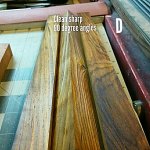I read a cue review on azbilliards, and the person described how the points on his cue were constructed. Only one side of a veneer actually reached the point. The other veneer was sliced off below the point. You can see that method of construction in the following image:

The innermost black point where the color is still deep black, the point ends centered in the middle of the white veneers, and from the tip of that deep black point there is a lighter black line that angles to the left. That line is where the left white veneer was sliced off. The white veneer on the right continues all the way up to form the white point. At the tip of the white point, once again you can see a black line angling left, which is where the green veneer was sliced off. Up higher, you can see the same thing with the orange veneers.
Up close, that construction method makes the points like like they veer to the left. What other methods are used to construct sharp points? Are some veneers mitered at the point, so that each veneer is a mirror image of the other veneer? Do different construction methods imply better quality?
Thank you
The innermost black point where the color is still deep black, the point ends centered in the middle of the white veneers, and from the tip of that deep black point there is a lighter black line that angles to the left. That line is where the left white veneer was sliced off. The white veneer on the right continues all the way up to form the white point. At the tip of the white point, once again you can see a black line angling left, which is where the green veneer was sliced off. Up higher, you can see the same thing with the orange veneers.
Up close, that construction method makes the points like like they veer to the left. What other methods are used to construct sharp points? Are some veneers mitered at the point, so that each veneer is a mirror image of the other veneer? Do different construction methods imply better quality?
Thank you

